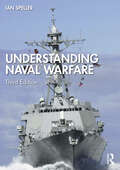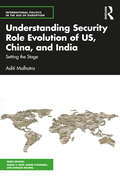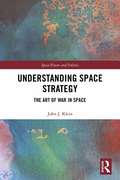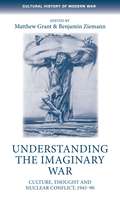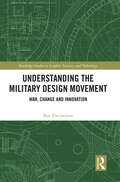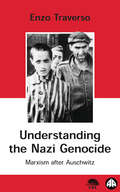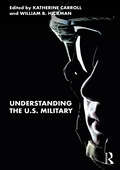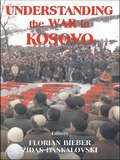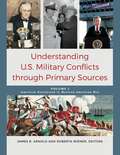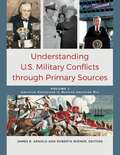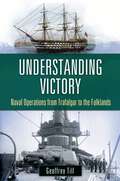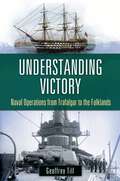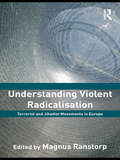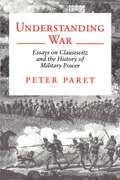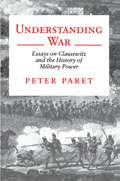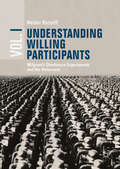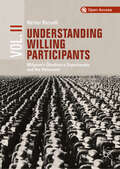- Table View
- List View
Understanding Naval Warfare
by Ian SpellerThis updated new edition of Understanding Naval Warfare offers the reader an accessible introduction to the study of modern naval warfare, providing a thorough grounding in the vocabulary, concepts, issues and debates, set within the context of relevant history. The third edition explains traditional concepts and explores current and emerging ideas concerning the theory and practice of naval warfare, relating these to recent events including Sino-American naval competition and the Russian-Ukraine War. Navies operate in an environment that most people do not understand and that many avoid. They are equipped with a bewildering range of ships, craft and other vessels and types of equipment, the purpose of which is often unclear. Writings on naval warfare are usually replete with references to esoteric concepts explained in specialist language that can serve as a barrier to understanding. This book cuts through the obscure and the arcane to offer a clear, coherent and accessible guide to the key features of naval warfare which will equip the reader with the knowledge and understanding necessary for a sophisticated engagement with the subject. The new edition is divided into two key parts. The first focuses on concepts of naval warfare and introduces readers to the ideas associated with the theory and practice of naval operations and includes a chapter where the history of the last century of naval warfare is explored in order to illustrate the key concepts. The second part focuses on the conduct of war at sea and on peacetime roles for contemporary navies and now includes new material on hybrid warfare and grey zone operations and on joint warfare, multi-domain operations and integrated deterrence within the context of evolving great power rivalry at sea. This textbook will be essential reading for students of naval warfare, sea power and maritime security and is highly recommended for those studying military history, strategic studies and security studies in general.
Understanding Naval Warfare
by Ian SpellerThis updated new edition of Understanding Naval Warfare offers the reader an accessible introduction to the study of modern naval warfare, providing a thorough grounding in the vocabulary, concepts, issues and debates, set within the context of relevant history. The third edition explains traditional concepts and explores current and emerging ideas concerning the theory and practice of naval warfare, relating these to recent events including Sino-American naval competition and the Russian-Ukraine War. Navies operate in an environment that most people do not understand and that many avoid. They are equipped with a bewildering range of ships, craft and other vessels and types of equipment, the purpose of which is often unclear. Writings on naval warfare are usually replete with references to esoteric concepts explained in specialist language that can serve as a barrier to understanding. This book cuts through the obscure and the arcane to offer a clear, coherent and accessible guide to the key features of naval warfare which will equip the reader with the knowledge and understanding necessary for a sophisticated engagement with the subject. The new edition is divided into two key parts. The first focuses on concepts of naval warfare and introduces readers to the ideas associated with the theory and practice of naval operations and includes a chapter where the history of the last century of naval warfare is explored in order to illustrate the key concepts. The second part focuses on the conduct of war at sea and on peacetime roles for contemporary navies and now includes new material on hybrid warfare and grey zone operations and on joint warfare, multi-domain operations and integrated deterrence within the context of evolving great power rivalry at sea. This textbook will be essential reading for students of naval warfare, sea power and maritime security and is highly recommended for those studying military history, strategic studies and security studies in general.
Understanding Security Role Evolution of US, China, and India: Setting the Stage (International Politics in the Age of Disruption)
by Aditi MalhotraThis book revolves around the altering security roles of three pivotal powers – the US, China, and India. Each of these actors has experienced incremental changes in their external roles and behaviour over the last two decades, which are determined by the range of domestic and international factors. As each country works towards performing its revised security roles, the policymakers are subject to dilemmas and challenges that impact policy implementation and conduct. Using the framework of role theory, the book analyses the role evolution of these countries and elucidates its link with their security policies in the Indo-Pacific and on the global stage. In the process, it also examines the systemic and sub-systemic factors that determine the foreign and security behaviour of these critical Indo-Pacific countries. Accessibly written, this volume will be of great interest to scholars and researchers of international relations, security and intelligence studies, political science, and foreign policy. It will also be of great interest to policymakers, career bureaucrats, security and intelligence practitioners, and professionals working with think tanks and embassies.
Understanding Security Role Evolution of US, China, and India: Setting the Stage (International Politics in the Age of Disruption)
by Aditi MalhotraThis book revolves around the altering security roles of three pivotal powers – the US, China, and India. Each of these actors has experienced incremental changes in their external roles and behaviour over the last two decades, which are determined by the range of domestic and international factors. As each country works towards performing its revised security roles, the policymakers are subject to dilemmas and challenges that impact policy implementation and conduct. Using the framework of role theory, the book analyses the role evolution of these countries and elucidates its link with their security policies in the Indo-Pacific and on the global stage. In the process, it also examines the systemic and sub-systemic factors that determine the foreign and security behaviour of these critical Indo-Pacific countries. Accessibly written, this volume will be of great interest to scholars and researchers of international relations, security and intelligence studies, political science, and foreign policy. It will also be of great interest to policymakers, career bureaucrats, security and intelligence practitioners, and professionals working with think tanks and embassies.
Understanding Space Strategy: The Art of War in Space (Space Power and Politics)
by John J. KleinThis book examines the rise of great power competition in space, including the relevant and practical space strategies for China, Russia, the United States, and other countries. The work discusses the concepts and writings of past strategists, such as Thucydides, Sun Tzu, and Clausewitz, in relation to warfare initiated in or extending into space. This analysis underscores why polities initiate war based upon an assessment of fear, honor, and interest, and explains why this will also be true of war in space. Based upon the timeless strategic writings of the past, the book uncovers the strategy of space warfare, along with the concepts of deterrence, dissuasion, and the inherent right of self-defense, and outlines strategies for great, medium, and emerging space powers. Additionally, it highlights changes needed to space strategy based upon the Law of Armed Conflict, norms of behavior, and Rules of Engagement. The work also examines advancements and emerging trends in the commercial space sector, as well as what these changes mean for the implementation of a practical space strategy. Given the rise of great power competition in space, this work presents a space strategy based upon historical experience. This book will be of much interest to students of space policy, strategic studies, and International Relations.
Understanding Space Strategy: The Art of War in Space (Space Power and Politics)
by John J. KleinThis book examines the rise of great power competition in space, including the relevant and practical space strategies for China, Russia, the United States, and other countries. The work discusses the concepts and writings of past strategists, such as Thucydides, Sun Tzu, and Clausewitz, in relation to warfare initiated in or extending into space. This analysis underscores why polities initiate war based upon an assessment of fear, honor, and interest, and explains why this will also be true of war in space. Based upon the timeless strategic writings of the past, the book uncovers the strategy of space warfare, along with the concepts of deterrence, dissuasion, and the inherent right of self-defense, and outlines strategies for great, medium, and emerging space powers. Additionally, it highlights changes needed to space strategy based upon the Law of Armed Conflict, norms of behavior, and Rules of Engagement. The work also examines advancements and emerging trends in the commercial space sector, as well as what these changes mean for the implementation of a practical space strategy. Given the rise of great power competition in space, this work presents a space strategy based upon historical experience. This book will be of much interest to students of space policy, strategic studies, and International Relations.
Understanding the imaginary war: Culture, thought and nuclear conflict, 1945–90 (PDF) (Cultural History of Modern War)
by Benjamin Ziemann Matthew GrantThis collection offers a fresh interpretation of the Cold War as an imaginary war, a conflict that had imaginations of nuclear devastation as one of its main battlegrounds. The book includes survey chapters and case studies on Western Europe, the USSR, Japan and the USA. Looking at various strands of intellectual debate and at different media, from documentary film to fiction, the chapters demonstrate the difficulties to make the unthinkable and unimaginable - nuclear apocalypse - imaginable. The book will be required reading for everyone who wants to understand the cultural dynamics of the Cold War through the angle of its core ingredient, nuclear weapons.
Understanding the imaginary war: Culture, thought and nuclear conflict, 1945–90 (Cultural History of Modern War)
by Benjamin Ziemann Matthew GrantThis collection offers a fresh interpretation of the Cold War as an imaginary war, a conflict that had imaginations of nuclear devastation as one of its main battlegrounds. The book includes survey chapters and case studies on Western Europe, the USSR, Japan and the USA. Looking at various strands of intellectual debate and at different media, from documentary film to fiction, the chapters demonstrate the difficulties to make the unthinkable and unimaginable - nuclear apocalypse - imaginable. The book will be required reading for everyone who wants to understand the cultural dynamics of the Cold War through the angle of its core ingredient, nuclear weapons.
Understanding the Military Design Movement: War, Change and Innovation (Routledge Studies in Conflict, Security and Technology)
by Ben ZweibelsonThis book explains the history and development of the military design movement, featuring case studies from key modern militaries. Written by a practitioner, the work shows how modern militaries think and arrange actions in time and space for security affairs, and why designers are disrupting, challenging, and reconceptualizing everything previously upheld as sacred on the battlefield. It is the first book to thoroughly explain what military design is, where it came from, and how it works at deep, philosophically grounded levels, and why it is potentially the most controversial development in generations of war fighters. The work explains the tangled origins of commercial design and that of designing modern warfare, the rise of various design movements, and how today’s military forces largely hold to a Newtonian stylization built upon mimicry of natural science infused with earlier medieval and religious inspirations. Why does our species conceptualize war as such, and how do military institutions erect barriers that become so powerful that efforts to design further innovation require entirely novel constructs outside the orthodoxy? The book explains design stories from the Israel Defense Force, the US Army, the US Marine Corps, the Canadian Armed Forces, and the Australian Defence Force for the first time, and includes the theory, doctrine, organizational culture, and key actors involved. Ultimately, this book is about how small communities of practice are challenging the foundations of modern defence thinking. This book will be of much interest to students of military and strategic studies, defence studies, and security studies, as well as design educators and military professionals.
Understanding the Military Design Movement: War, Change and Innovation (Routledge Studies in Conflict, Security and Technology)
by Ben ZweibelsonThis book explains the history and development of the military design movement, featuring case studies from key modern militaries. Written by a practitioner, the work shows how modern militaries think and arrange actions in time and space for security affairs, and why designers are disrupting, challenging, and reconceptualizing everything previously upheld as sacred on the battlefield. It is the first book to thoroughly explain what military design is, where it came from, and how it works at deep, philosophically grounded levels, and why it is potentially the most controversial development in generations of war fighters. The work explains the tangled origins of commercial design and that of designing modern warfare, the rise of various design movements, and how today’s military forces largely hold to a Newtonian stylization built upon mimicry of natural science infused with earlier medieval and religious inspirations. Why does our species conceptualize war as such, and how do military institutions erect barriers that become so powerful that efforts to design further innovation require entirely novel constructs outside the orthodoxy? The book explains design stories from the Israel Defense Force, the US Army, the US Marine Corps, the Canadian Armed Forces, and the Australian Defence Force for the first time, and includes the theory, doctrine, organizational culture, and key actors involved. Ultimately, this book is about how small communities of practice are challenging the foundations of modern defence thinking. This book will be of much interest to students of military and strategic studies, defence studies, and security studies, as well as design educators and military professionals.
Understanding the Nazi Genocide: Marxism After Auschwitz (IIRE (International Institute for Research and Education))
by Enzo Traverso'...this is a genuinely original contribution to our understanding. Students of the Holocaust sometimes worry that too much analysis may immunise us against its unbelievable horror. Traverso avoids that risk with great sensitivity and imagination.' Socialist Review In Understanding the Nazi Genocide Enzo Traverso sustains a dialogue with writings on the Shoah from Hannah Arendt to Daniel Goldhagen by drawing on the critical and heretical Marxism of Walter Benjamin and the Frankfurt School, which grasped late capitalism’s pent-up capacity for destructive upheavals exacerbated by bureaucratic organisation and advanced technology.After Auschwitz, Hiroshima and the gulag, the old warning slogan - socialism or barbarism - formulated by European Marxists at the beginning of twentieth century needs to be seriously ‘revised’. The choice we face today is no longer between the progress of civilisation and a fall into ancient savagery, but between socialism conceived as a new civilisation and the destruction of humankind. For Traverso the Warsaw Ghetto uprising is an image of what should impel us to rebel: not a sense of inevitable victory, but an ethical imperative.
Understanding the U.S. Military
by Katherine Carroll William B. HickmanThis book offers an accessible introduction to the U.S. military as an institution and provides insights into the military’s structure and norms. Designed for undergraduate students, the book offers an interdisciplinary overview of America’s armed forces through three critical lenses. First, it introduces the military’s constitutional and historical context. Second, it presents concise factual information chosen for its relevance to the military’s structures, procedures, norms, and varied activities. Finally, it intersperses these facts with debates, theories, and questions to spark student interest, class discussion, and further research. The text is written for the beginner but covers complex topics such as force structure and the defense budget. With contributions informed by both scholarly approaches and long military careers, the book will prepare students for further studies in international relations, civil-military relations, or U.S. foreign policy. It also encourages critical thinking, elucidating an institution that undergraduates and other civilians too often perceive as both baffling and above reproach. This book will be of much interest to students of the U.S. military, civil-military relations, U.S. politics, and public policy.
Understanding the U.S. Military
by Katherine Carroll William B. HickmanThis book offers an accessible introduction to the U.S. military as an institution and provides insights into the military’s structure and norms. Designed for undergraduate students, the book offers an interdisciplinary overview of America’s armed forces through three critical lenses. First, it introduces the military’s constitutional and historical context. Second, it presents concise factual information chosen for its relevance to the military’s structures, procedures, norms, and varied activities. Finally, it intersperses these facts with debates, theories, and questions to spark student interest, class discussion, and further research. The text is written for the beginner but covers complex topics such as force structure and the defense budget. With contributions informed by both scholarly approaches and long military careers, the book will prepare students for further studies in international relations, civil-military relations, or U.S. foreign policy. It also encourages critical thinking, elucidating an institution that undergraduates and other civilians too often perceive as both baffling and above reproach. This book will be of much interest to students of the U.S. military, civil-military relations, U.S. politics, and public policy.
Understanding the War in Kosovo
by Florian Bieber idas DaskalovskiThe war in Kosovo has been a defining moment in post-Cold War Europe. Kosovo has great importance beyond the Balkans as the most ambitious attempt of the international community to prevent internal conflicts and rebuild a society destroyed by war and ethnic cleansing. As the danger of ethnic conflict prevails in the region and elsewhere around the world, the experience of Kosovo offers important lessons. This is a comprehensive survey of developments in Kosovo leading up to, during and after the war in 1999, providing additionally the international and regional framework to the conflict. It examines the underlying causes of the war, the attempts by the international community to intervene, and the war itself in spring 1999. It critically examines the international administration in Kosovo since June 1999 and contextualizes it within the relations of Kosovo to its neighbours and as part of the larger European strategy in Southeastern Europe with the stability pact. It does not seek to promote one interpretation of the conflict and its aftermath, but brings together a range of intellectual arguments from some sixteen researchers from the Balkans, the rest of Europe and North America.
Understanding the War in Kosovo
by Florian Bieber Zidas DaskalovskiThe war in Kosovo has been a defining moment in post-Cold War Europe. Kosovo has great importance beyond the Balkans as the most ambitious attempt of the international community to prevent internal conflicts and rebuild a society destroyed by war and ethnic cleansing. As the danger of ethnic conflict prevails in the region and elsewhere around the world, the experience of Kosovo offers important lessons. This is a comprehensive survey of developments in Kosovo leading up to, during and after the war in 1999, providing additionally the international and regional framework to the conflict. It examines the underlying causes of the war, the attempts by the international community to intervene, and the war itself in spring 1999. It critically examines the international administration in Kosovo since June 1999 and contextualizes it within the relations of Kosovo to its neighbours and as part of the larger European strategy in Southeastern Europe with the stability pact. It does not seek to promote one interpretation of the conflict and its aftermath, but brings together a range of intellectual arguments from some sixteen researchers from the Balkans, the rest of Europe and North America.
Understanding U.S. Military Conflicts through Primary Sources [4 volumes]: [4 volumes]
by James R. Arnold and Roberta WienerAn easily accessible resource that showcases the links between using documented primary sources and gaining a more nuanced understanding of military history.Primary source analysis is a valuable tool that teaches students how historians utilize documents and interpret evidence from the past. This four-volume reference traces key decisions in U.S. military history—from the Revolutionary War through the 21st-century conflicts in Afghanistan and Iraq—by examining documents relating to military strategy and national policy judgments by U.S. military and political leaders.A comprehensive introductory essay provides readers with the context necessary to understand the relationship between diplomatic documents, military correspondence, and other documentation related to events that shaped warfare, diplomacy, and military strategy. Once the stage is set, the work covers 14 conflicts that are significant to U.S. history. Treatment of each of the conflicts begins with a historical overview followed by a chronology and approximately 30 primary source documents presented in chronological order. Each document is accompanied by a description and annotations and by an analysis that highlights its importance to the event or topic under discussion. Designed for secondary school and college students, the work will be exceptionally valuable to teachers who will appreciate the ready-made lessons that fit directly into core curriculum standards.
Understanding U.S. Military Conflicts through Primary Sources [4 volumes]: [4 volumes]
An easily accessible resource that showcases the links between using documented primary sources and gaining a more nuanced understanding of military history.Primary source analysis is a valuable tool that teaches students how historians utilize documents and interpret evidence from the past. This four-volume reference traces key decisions in U.S. military history—from the Revolutionary War through the 21st-century conflicts in Afghanistan and Iraq—by examining documents relating to military strategy and national policy judgments by U.S. military and political leaders.A comprehensive introductory essay provides readers with the context necessary to understand the relationship between diplomatic documents, military correspondence, and other documentation related to events that shaped warfare, diplomacy, and military strategy. Once the stage is set, the work covers 14 conflicts that are significant to U.S. history. Treatment of each of the conflicts begins with a historical overview followed by a chronology and approximately 30 primary source documents presented in chronological order. Each document is accompanied by a description and annotations and by an analysis that highlights its importance to the event or topic under discussion. Designed for secondary school and college students, the work will be exceptionally valuable to teachers who will appreciate the ready-made lessons that fit directly into core curriculum standards.
Understanding Victory: Naval Operations from Trafalgar to the Falklands (War, Technology, and History)
by Geoffrey TillUsing four warship-centered examples, this book shows how naval battles are won or lost—and how technological advantage is rarely as decisive in defeat or victory as is often claimed.Providing a unique assessment of naval strategy and historic outcomes across centuries of warfare, Understanding Victory: Naval Operations from Trafalgar to the Falklands presents four case studies that examine each ship-based battle narrative to expose and analyze the factors that contributed to each side's success or defeat. The work opens with an overview of the general causes of success and failure in naval operations. Each case study starts with a detailed narrative of the battle and then reviews the conflict from the key perspectives identified in the introduction. These classic examples of naval warfare underscore how the outcome of naval operations is often predetermined by the clarity and quality of the mission aim, and point out striking constants in naval warfare despite the obvious differences in military technologies over a long span of time.
Understanding Victory: Naval Operations from Trafalgar to the Falklands (War, Technology, and History)
by Geoffrey TillUsing four warship-centered examples, this book shows how naval battles are won or lost—and how technological advantage is rarely as decisive in defeat or victory as is often claimed.Providing a unique assessment of naval strategy and historic outcomes across centuries of warfare, Understanding Victory: Naval Operations from Trafalgar to the Falklands presents four case studies that examine each ship-based battle narrative to expose and analyze the factors that contributed to each side's success or defeat. The work opens with an overview of the general causes of success and failure in naval operations. Each case study starts with a detailed narrative of the battle and then reviews the conflict from the key perspectives identified in the introduction. These classic examples of naval warfare underscore how the outcome of naval operations is often predetermined by the clarity and quality of the mission aim, and point out striking constants in naval warfare despite the obvious differences in military technologies over a long span of time.
Understanding Violent Radicalisation: Terrorist and Jihadist Movements in Europe (Political Violence)
by Magnus RanstorpThis is the first book to address in depth the interplay between radicalisation and political violence in Europe, as well as the effectiveness of counter-measures. As evidenced from the multitude of intercepted plots across several European cities since 2001, the threat level and the intensity of the desire to perpetrate mass-casualty attacks within Europe is not diminishing. While violent radicalization has gradually moved to the top of the EU counterterrorism agenda, it has been accompanied by a relatively embryonic understanding about the processes and interplay of factors that contribute to radicalization, which are played out differently in cities like Paris, Rome, London and Copenhagen. Undoubtedly, there are common factors at the global and regional levels that facilitate radicalization, but it is also clear that radicalization is very context dependent. This book provides crucial insights into different ways to understand violent radicalization within national contexts and the challenges addressing the many pathways into terrorism inspired by al-Qaeda and other forms of Islamic extremism. This book will be of great interest to students of terrorism studies and political violence, counter-terrorism, EU politics, security studies and IR in general. Magnus Ranstorp is Research Director of the Center for Asymmetric Threat Studies at the Swedish National Defence College and a Member of EU Expert Groups on (Violent) Radicalisation. He has twenty years of experience in research on counterterrorism issues and testified at the 9/11 Commission Hearing.
Understanding Violent Radicalisation: Terrorist and Jihadist Movements in Europe (Political Violence)
by Magnus RanstorpThis is the first book to address in depth the interplay between radicalisation and political violence in Europe, as well as the effectiveness of counter-measures. As evidenced from the multitude of intercepted plots across several European cities since 2001, the threat level and the intensity of the desire to perpetrate mass-casualty attacks within Europe is not diminishing. While violent radicalization has gradually moved to the top of the EU counterterrorism agenda, it has been accompanied by a relatively embryonic understanding about the processes and interplay of factors that contribute to radicalization, which are played out differently in cities like Paris, Rome, London and Copenhagen. Undoubtedly, there are common factors at the global and regional levels that facilitate radicalization, but it is also clear that radicalization is very context dependent. This book provides crucial insights into different ways to understand violent radicalization within national contexts and the challenges addressing the many pathways into terrorism inspired by al-Qaeda and other forms of Islamic extremism. This book will be of great interest to students of terrorism studies and political violence, counter-terrorism, EU politics, security studies and IR in general. Magnus Ranstorp is Research Director of the Center for Asymmetric Threat Studies at the Swedish National Defence College and a Member of EU Expert Groups on (Violent) Radicalisation. He has twenty years of experience in research on counterterrorism issues and testified at the 9/11 Commission Hearing.
Understanding War: Essays on Clausewitz and the History of Military Power
by Peter ParetThese essays provide an authoritative introduction to Carl von Clausewitz and enlarge the history of war by joining it to the history of ideas and institutions and linking it with intellectual biography.
Understanding War: Essays on Clausewitz and the History of Military Power
by Peter ParetThese essays provide an authoritative introduction to Carl von Clausewitz and enlarge the history of war by joining it to the history of ideas and institutions and linking it with intellectual biography.
Understanding Willing Participants, Volume 1: Milgram’s Obedience Experiments and the Holocaust
by Nestar RussellHorrified by the Holocaust, social psychologist Stanley Milgram wondered if he could recreate the Holocaust in the laboratory setting. Unabated for more than half a century, his (in)famous results have continued to intrigue scholars. Based on unpublished archival data from Milgram’s personal collection, volume one of this two-volume set introduces readers to a behind the scenes account showing how during Milgram’s unpublished pilot studies he step-by-step invented his official experimental procedure—how he gradually learnt to transform most ordinary people into willing inflictors of harm. Volume two then illustrates how certain innovators within the Nazi regime used the very same Milgram-like learning techniques that with increasing effectiveness gradually enabled them to also transform most ordinary people into increasingly capable executioners of other men, women, and children. Volume two effectively attempts to capture how step-by-step these Nazi innovators attempted to transform the Führer’s wish of a Jewish-free Europe into a frightening reality. By the books’ end the reader will gain an insight into how the seemingly undoable can become increasingly doable.
Understanding Willing Participants, Volume 2: Milgram’s Obedience Experiments and the Holocaust
by Nestar RussellHorrified by the Holocaust, social psychologist Stanley Milgram wondered if he could recreate the Holocaust in the laboratory setting. Unabated for more than half a century, his (in)famous results have continued to intrigue scholars. Based on unpublished archival data from Milgram’s personal collection, volume one of this two-volume set introduces readers to a behind the scenes account showing how during Milgram’s unpublished pilot studies he step-by-step invented his official experimental procedure—how he gradually learnt to transform most ordinary people into willing inflictors of harm. The open access volume two then illustrates how certain innovators within the Nazi regime used the very same Milgram-like learning techniques that with increasing effectiveness gradually enabled them to also transform most ordinary people into increasingly capable executioners of other men, women, and children. Volume two effectively attempts to capture how step-by-step these Nazi innovators attempted to transform the Führer’s wish of a Jewish-free Europe into a frightening reality. By the books’ end the reader will gain an insight into how the seemingly undoable can become increasingly doable.
